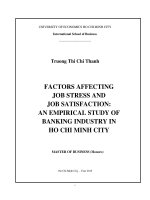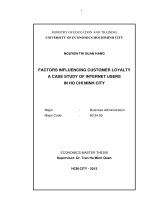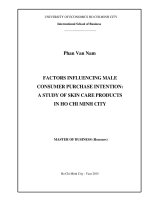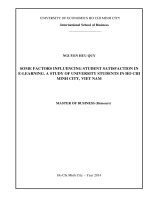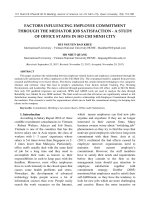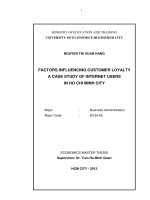Factors Influencing Job Satisfaction A Case Study Of Generation Z In White - Collar Sector In Ho Chi Minh City, 2022.Pdf
Bạn đang xem bản rút gọn của tài liệu. Xem và tải ngay bản đầy đủ của tài liệu tại đây (1.36 MB, 134 trang )
MINISTRY OF EDUCATION AND TRAINING
THE STATE BANK OF VIET NAM
BANKING UNIVERSITY OF HO CHI MINH CITY
LE THUY TUYET NGHI
FACTORS INFLUENCING JOB SATISFACTION:
A CASE STUDY OF GENERATION Z IN WHITE-COLLAR SECTOR
IN HO CHI MINH CITY
GRADUATE THESIS
MAJOR: BUSINESS ADMINISTRATION
CODE: 7340101
SUPERVISOR
Dr. Bui Duc Sinh
HO CHI MINH CITY, 2022
Tai ngay!!! Ban co the xoa dong chu nay!!!
MINISTRY OF EDUCATION AND TRAINING
THE STATE BANK OF VIET NAM
BANKING UNIVERSITY OF HO CHI MINH CITY
LE THUY TUYET NGHI
FACTORS INFLUENCING JOB SATISFACTION:
A CASE STUDY OF GENERATION Z IN WHITE-COLLAR SECTOR
IN HO CHI MINH CITY
GRADUATE THESIS
MAJOR: BUSINESS ADMINISTRATION
CODE: 7340101
SUPERVISOR
Dr. Bui Duc Sinh
HO CHI MINH CITY, 2022
i
ABSTRACT
Job satisfaction is a high priority for the Human Resources workforce since
the level of employees’ contentment could lead to higher productivity, profitability,
and complete organizational commitment. In recent years, most organizations have
faced considerable challenges in attracting and retaining employees from
Generation Z since they appear to have higher requirements for their jobs compared
to their predecessors. Thus, the objective of this study is to investigate the factors
influencing Generation Z employees working in offices in Ho Chi Minh City.
Preliminary quantitative research was initially conducted with 50 participants to
modify the scales and eliminate unreliable items. Subsequently, official data were
collected from 300 Generation Z employees in Ho Chi Minh City via an online
questionnaire. The results reveal seven proposed factors contributing to Generation
Z officers in Ho Chi Minh City. In which, Salary & Benefits have the most decisive
effect on job satisfaction of this age group, while the weakest component is
Working environement. The study also presents practical implications and further
research directions to enrich this aspect of human resources management.
Keywords: Job satisfaction, Generation Z, Human Resources Management
ii
DECLARATION
I formally declare that I wrote this thesis under the guidance of Dr. Bui Duc
Sinh; and the findings presented in this thesis are honest and not against ethical
issues in conducting research.
I clearly listed all the literature and sources that I employed while writing
this academic research. Moreover, I commit that the data collected were
confidential and solely used for this thesis.
I am fully responsible if the violation of this regulation is found in my thesis.
Author’s signature
iii
ACKNOWLEDGEMENT
Words cannot describe my gratitude to my family and beloved friends who
emotionally and mentally supported me whenever I struggled with my thesis. This
endeavor could not have been possible without their encouragement.
Besides, I sincerely appreciate every respondent who was willing to
participate in the survey so that the data collection process could occur efficiently.
Eventually, I would like to express my appreciation to Dr. Bui Duc Sinh. His
instructions and constructive advice have helped improve my thesis significantly.
Without his supervision, this thesis would not have been completed effectively.
iv
TABLES OF CONTENT
ABSTRACT ............................................................................................................... i
DECLARATION ...................................................................................................... ii
ACKNOWLEDGEMENT ...................................................................................... iii
LIST OF ACRONNYMS ....................................................................................... vii
LIST OF TABLES .................................................................................................. ix
LIST OF FIGURES ..................................................................................................x
CHAPTER 1: INTRODUCTION ............................................................................1
1.1
Research Statement........................................................................................1
1.2
Research Objectives ......................................................................................2
1.3
Research Questions........................................................................................3
1.4
Research Subjects and Scope ........................................................................3
1.5
Research Methodology ..................................................................................3
1.6
Research Significance....................................................................................4
1.7 Research Structure .............................................................................................4
SUMMARY OF CHAPTER 1 .................................................................................5
CHAPTER 2: LITERATURE REVIEW ................................................................6
2.1
Generation Z ..................................................................................................6
2.1.1
Definition of Generation Z .....................................................................6
2.1.2
Characteristics of Generation Z ..............................................................6
2.2
Job Satisfaction ..............................................................................................7
2.2.1
Definitions of job satisfaction .................................................................8
2.2.2
Measures of job satisfaction ...................................................................9
2.3
Theories on motivation ................................................................................10
2.3.1
Abraham Maslow’s Need Theory (1943) .............................................11
2.3.2
Herzberg’s two-factor theory ................................................................13
2.3.3
Vroom’s expectancy theory ..................................................................14
2.4
Previous Studies ..........................................................................................15
2.4.1
Domestic Studies ..................................................................................15
v
2.4.2
2.5
Foreign Studies .....................................................................................17
Research Model and Hypotheses .................................................................20
2.5.1
Research Model ....................................................................................20
2.5.2
Hypotheses ............................................................................................22
SUMMARY OF CHAPTER 2 ...............................................................................31
CHAPTER 3: METHODOLOGY .........................................................................32
3.1.
Research Process .........................................................................................32
3.2.
Research Design ..........................................................................................33
3.3.
Data Collection ............................................................................................34
3.3.1
Sample Size...........................................................................................34
3.3.2
Sampling method ..................................................................................34
3.3.3
Scale formulation ..................................................................................34
3.3.4
Questionnaire Design ............................................................................38
3.4
Preliminary quantitative research ................................................................38
3.4.1
Preliminary quantitative research process ............................................38
3.4.2
Preliminary quantitative research results ..............................................38
3.5
Formal Research ..........................................................................................40
3.6
Data Analysis Techniques ...........................................................................42
3.4.1
Descriptive statistics .............................................................................42
3.4.2
Cronbach’s Alpha Analysis ..................................................................42
3.4.3
Exploratory factor analysis (EFA) ........................................................43
3.4.4
Regression analysis ...............................................................................44
3.4.5
Testing differences based on Controlled Variables ..............................44
SUMMARY OF CHAPTER 3 ...............................................................................45
CHAPTER 4: RESULTS ........................................................................................46
4.1
Descriptive Statistics ...................................................................................46
4.2
Scale Reliability Testing ..............................................................................48
4.3
Exploratory Factor Analysis ........................................................................51
4.3.1
Factor analysis for the independent variable ........................................51
vi
4.3.2
Factor analysis for the dependent variable ...........................................53
4.4
Correlation Analysis ....................................................................................54
4.5
Regression Analysis ....................................................................................55
4.5.1
Tests of Model Fit .................................................................................55
4.5.2
Regression Coefficients ........................................................................56
4.5.3
Hypothesis Testing ...............................................................................57
4.6
Testing differences based on Controlled Variables .....................................61
4.6.1
Testing differences in gender ................................................................61
4.6.2
Testing differences in income ...............................................................62
4.6.3
Testing differences in experience .........................................................64
4.6.4
Testing differences in specialization ....................................................64
4.7 Result discussion .............................................................................................65
SUMMARY OF CHAPTER 4 ...............................................................................67
CHAPTER 5: CONCLUSION ...............................................................................68
5.1
Conclusion ...................................................................................................68
5.2
Managerial Implications ..............................................................................69
5.3
Limitations and further research ..................................................................72
REFERENCES ........................................................................................................73
APPENDIX 1: MEASUREMENT SCALES OF OBSERVED VARIABLES .....84
APPENDIX 2: QUESTIONNAIRE SURVEY .....................................................87
APPENDIX 3: PRELIMINARY RESEARCH RESULTS .................................92
APPENDIX 4: DESCRIPTIVE STATISTICS .....................................................97
APPENDIX 5: CRONBACH’S ALPHA .............................................................104
APPENDIX 6: EXPLORATORY FACTOR ANALYSIS (EFA) .....................108
APPENDIX 7: CORRELATION ANALYSIS ...................................................113
APPENDIX 8: REGRESSION ANALYSIS .......................................................115
APPENDIX 9: TESTS OF DIFFERENCES ......................................................118
vii
LIST OF ACRONNYMS
Acronyms
Meaning
SB
Salary & Benefits
WE
Working environment
JC
Job Characteristics
TP
Training & Promotion
SV
Supervisor
CW
Co-workers
WLB
JS
SPSS
SIG
ANOVA
Work-life Balance
Job Satisfaction
Statistical Package for the Social Sciences
Significance level
Analysis of Variance
EFA
Exploratory Factor Analysis
KMO
Kaiser-Mayer-Olkin
VIF
Variance inflation factor
JDI
Job Descriptive Index
MSQ
Minnesota Satisfaction Questionnaire
JSS
Job Satisfaction Survey
JDS
Job Diagnostic Survey
GJS
Global Job Satisfaction
viii
JIG
HRM
Job in General Scale
Human Resource Management
ix
LIST OF TABLES
Table 2.1 - Previous studies summary ......................................................................18
Table 2.2 - Summary of the author's hypotheses and expectations ..........................30
Table 3.1 - Measurement scale of observed variables ..............................................35
Table 3.2 - Scale Reliability Testing of Preliminary quantitative research ..............39
Table 3.3 - Formal Research Scale ...........................................................................40
Table 4.1 - Sample Description .................................................................................47
Table 4.2 - Reliability Analysis Results ....................................................................49
Table 4.3 - Factor analysis for the independent variables.........................................51
Table 4.4 - Factor analysis for Dependent variable ..................................................53
Table 4.5 - Pearson correlation analysis ...................................................................55
Table 4.6 - Model Summary .....................................................................................55
Table 4.7 - ANOVA Analysis ...................................................................................56
Table 4.8 - Coefficients Analysis ..............................................................................56
Table 4.9 - Summary of hypothesis testing results ...................................................59
Table 4.10 - One-way analysis of variance by gender ..............................................61
Table 4.11 - One-way analysis of variance by income .............................................62
Table 4.12 - Post Hoc test by Income .......................................................................62
Table 4.13 - One-way analysis of variance by Experience .......................................64
Table 4.14 - One-way analysis of variance by Specialization ..................................65
Table 4.15 - Beta synthesis and the influence level of 7 factors ...............................66
x
LIST OF FIGURES
Figure 2.1 - Maslow's Hierarchy of Needs ...............................................................11
Figure 2.2 - Herzberg’s two-factor theory ................................................................13
Figure 2.3 - Vroom’s expectancy theory ..................................................................14
Figure 2.4 - Proposed research model .......................................................................22
Figure 3.1 - Research Process ...................................................................................33
Figure 4.2 – Completed research model ...................................................................61
CHAPTER 1: INTRODUCTION
Chapter 1 explains why this topic was chosen and provides an overview of
research objectives, questions, methodologies, and research scope. Additionally,
this chapter also presents the research’s significance in terms of academics and
practice. Eventually, the presentation structure of this research is outlined.
1.1 Research Statement
Job satisfaction is one of major priorities of Human Resources personnel since
high job satisfaction could reduce turnover, increase work productivity and build
organizational loyalty within employees. Because of its significance, job
satisfaction has sparked the widespread interest of social psychologists, researchers
and administrators. They have developed instruments to measure the level of
satisfaction of employees towards their jobs, some of which are Minnesota
Satisfaction Questionnaire (MSQ) (Weiss et al., 1967), Job Description Index (JDI)
(Smith, Kendall & Hulin, 1969), Job Diagnostic Survey (JDS) (Hackman, Oldham,
1974) and Job Satisfaction Survey (Spector, 1997).
However, those instruments seem quite general since they failed to fully reflect
different aspects of both typical and specific organizations. Some of them were
proposed based on white-collar jobs while the others were solely applicable for
specific sectors such as healthcare and service workers (Astrauskaite et al., 2011).
On the other hand, this diversity has demonstrated different aspects of
organizational sectors and provided academic scholars a variety of options which
suit the sample of their research. As a result, most previous studies related to job
satisfaction, researchers had to modify the chosen instrument or combine it with
another in order to propose a model thats fit their organizations.
It is noticeable that each generation has different patterns in perceptions,
working styles and job satisfaction because they grow up in dissimilar economic
1
situations, social conditions and cultural environment. Thus, it is crucial for
corporates to understand every generation in order to create and retain a suitable
workplace. Granted that extensive studies have conducted on Millennial or
Generation Y over the past decades, but little to none on Centennial or Generation
Z. Meanwhile, Generation Z is gradually entering the labor market while the Baby
Boomers are beginning their retirement. According to PwC’s report “How digital
ready is Generation Z” - Findings from PwC Vietnam’s Digital Readiness Survey
2020, Generation Z is estimated to account for roughly one-third of the total
Vietnamese labor market by 2025. In recent years, all contemporary organizations
have faced a significant challenge in attracting and retaining Generation Z
employees since they seem to have more demands in their jobs compared to their
predecessors. Accordingly, a deeper and insightful understanding about the
characteristics of this cohort and their job expectations could help reduce generation
gap and foster collaboration among different generations in the workplace.
Globally, there are some studies on this new generation using quantitative
method conducted by Aggarwal et al. (2020) and Husainah, Hafnidar & Limakrisna
(2022), and some of them are mainly based on secondary data. In Vietnam, research
on Generation Z’s job satisfaction has been rarely found.
Having recognized the generation shift in the current labor market and its
significant effect in the long run, the author decided to choose the topic: “Factors
influencing job satisfaction: A case study of Generation Z in white-collar sector
in Ho Chi Minh city” to explore and examine factors affecting this new generation.
1.2 Research Objectives
The general objective of this study is to determine factors affecting the job
satisfaction of Generation Z working in Ho Chi Minh City. Subsequently,
management implications will be suggested based on the research results to help
bridge the generation gap in the current labor market. In order to achieve these
aims, this study has the following specific objectives:
2
To identify factors contributing to job satisfaction of Generation Z working in
different speclizations in Ho Chi Minh City.
To measure the impact level of each factor on job satisfaction of Generation Z
working in different speclizations in Ho Chi Minh City.
To suggest management implications to improve Generation Z’s job satisfaction.
1.3 Research Questions
Based on the research objectives and research problems above, this study
concentrates on answering the following questions:
Which factors are affecting on job satisfaction of Generation Z?
How is the degree of influence of each factor on job satisfaction of Generation
Z?
Which management implications could enhance job satisfaction of Generation
Z?
1.4 Research Subjects and Scope
This study concentrates on investigating the influence of factors on job
satisfaction of Generation Z.
In terms of space: This study focuses on Generation Z who are from 20 to 27 years
old and currently working in Ho Chi Minh City.
In terms of time: The fundamental statistical information is gathered by conducting
a questionnaire from October 2022 to November 2022.
1.5 Research Methodology
This study involves both qualitative technique and quantitative techniques.
The qualitative technique involves collecting and analyzing non-numerical data
through articles, theories, and previous studies related to factors affecting job
satisfaction. Based on those resources, this study proposes a model of factors
contributing to job satisfaction of Generation Z in Ho Chi Minh City.
3
Quantitative technique involves collecting and analyzing numerical data by
undertaking a survey into job satisfaction whose participants are mainly from 20 to
27 years old and currently working in Ho Chi Minh City. Subsequently, this
research uses SPSS 22.0 to perform the following quantitative analysis:
Descriptive statistics of the sample
Internal Consistency (Cronbach Alpha)
Exploratory Factor Analysis (EFA)
Correlation Analysis
Regression Analysis
1.6 Research Significance
Identifying, assessing, and analyzing factors that are currently contributing to
Generation Z’s job satisfaction could help gain better insights about this generation
and their job expectations. Statistical evidence and conclusions of this thesis could
help overcome the generation gap in the workplace as well as increase job
satisfaction and organizational commitment of Generation Z.
1.7 Research Structure
Besides the cover page, the declaration, acknowledgment, table of contents, lists
of acronyms, figures, and tables, abstract, as well as references, and appendixes, this
thesis includes five chapters as follows:
Chapter 1: Introduction
Chapter 2: Literature Review
Chapter 3: Methodology
Chapter 4: Results
Chapter 5: Conclusions & Implications
4
SUMMARY OF CHAPTER 1
This chapter has discussed an overview issues-related this topic, including the
urgency of the research, research objectives and questions, research’s methods, and
data, and finally the research’s contributions. Based on the discussion above, the
subject “FACTORS INFLUENCING JOB SATISFACTION: A CASE STUDY
OF GENERATION Z IN WHITE-COLLAR SECTOR IN HO CHI MINH
CITY” is scientific and practical. This helps establish a basis for further research
steps which mainly concentrate on presenting the theoretical framework, research
methods, and data collection to obtain research results, provide findings and draw
conclusions.
5
CHAPTER 2: LITERATURE REVIEW
Chapter 2 demonstrates theoretical underpinnings in relation to job
satisfaction and Generation Z. Based on theories and previous studies, this chapter
proposes a research model for the study.
2.1 Generation Z
2.1.1 Definition of Generation Z
Generation Z refers to individuals born since 1995 (Reeves & Oh, 2007;
Bassiouni
& Hackley; 2014). However, there are still some arguments about exactly this
cohort ends. According to Wood (2013), this generation includes those born in the
early 2000s, whereas others state that it lasts until 2010 (Bencsik, Horváth-Csikós &
Juhász, 2016; Mohr & Mohr, 2017). Despite that, most researchers claim that this
age group was born and raised during rapid technological development. In addition,
they are considered to be the initial generation experiencing globalization and
cultural diversity. This is because they had accessibility to others from different
backgrounds from a very young age though social media, and experienced
economic depression, terrorism, climate change, and the global spread of worldwide
brands during their childhood (McCrindle, 2014). As such, Generation Z is
described as Digital Natives (Prensky, 2001), Instant Online (Levickaite, 2010),
Tech Generation (Berkup, 2014), and Global Generation (McCrindle, 2014;
Stillman & Stillman, 2017).
2.1.2 Characteristics of Generation Z
In recent years, researchers, educators, and sociologists have conducted
multiple surveys to analyze the characteristics of this new generation. Having
grown up in such a modern and changeable era, Generation Z has several manners,
preferences, and mindsets that are unique and different from their predecessors.
6
This represents difficult challenges to managers, supervisors, human resource
leaders, and educators in every sector. (Tulgan, 2013).
This cohort is believed to be capable of obtaining the information they need
quickly, so they are self-educated and self-efficient rather than seeking interaction
with experts (Schwieger & Ladwig, 2018). However, this leads them to have a short
attention span (Stuckey, 2016), be impatient, and always want everything to occur
immediately (Berkup, 2014). According to (McAlpine, 2013), Generation Z is
expected to be more frugal with their money than previous generations as they
witnessed long-term parental unemployment during the Great Recession. Other
features of this generation are their individualism, competitive spirits, and
enterprising mindsets. Accordingly, they ache to be treated equally and respectfully
(Schwieger & Ladwig, 2018), always seek challenges around them and have a
strong desire to influence the world (Bencsik, Horváth-Csikós & Juhász, 2016)
When it comes to the workforce, these character characteristics have a great
influence on this generation’s manners and perceptions. According to Racolţa-Paina
& Irini (2021), retaining and motivating Generation Z are becoming strenuous since
this cohort seems to have more demands than the earlier generations. In the past few
years, contemporary organizations have been dealing with problems related to
workforce diversity including gender, race, ethnicity, religion, and generation gaps.
Therefore, the arrival of Generation Z into the workforce does not only raise new
challenges for companies, but it also represents a significant shift in how
organizations operate, communicate, and solve problems.
2.2 Job Satisfaction
Job satisfaction has always been a major concern for most institutes and
organizations. From employees’ perspective, it is the main reason for them to
decide whether to stay or leave the company (Pratama, Suwarni, & Handayani,
2022). In terms of organizations, job satisfaction is closely correlated with
organizational outcomes such as employee performance, absenteeism, productivity,
7
work output and turnover (Onukwube, 2012). Because of its profound influence,
various researchers have endeavored to define and measure it in different ways to
grasp its concepts.
2.2.1 Definitions of job satisfaction
The term was brought to the forefront by Hoppock (1935). He states that job
satisfaction is any combination of psychological, physiological, and environmental
conditions that leads a person to honestly say "I am satisfied with my job." Such
definition indicates that job satisfaction is affected by objective and subjective
factors. Meanwhile, Vroom (1964) refers job satisfaction as positive feedbacks from
individuals towards their current jobs. It can be seen that his definition emphasizes
employees’ roles in the workplace. Locke (1969) defines job satisfaction as a
“pleasurable or positive emotional state resulting from the appraisal of one’s or job
experiences”. In other words, job satisfaction is an emotional response towards
work situation. Spector (1997) describes job satisfaction as the degree to which
people like their jobs. Weiss (2002) proposes a clearer definition which indicates
that job satisfaction is affective evaluations including negative and positive feelings
an employee develops in relation with his or her job. This definition has been
supported by Mullins (2005) who defines job satisfaction as an inner feeling that
employees have towards their jobs. Besides, he also claims that job satisfaction is a
complicated and multifaced concept which varies widely to different people.
In summary, there have been various perspectives on job satisfaction. The
definitions developed from an overall viewpoint to a detailed assessment. The
former indicates that job satisfaction is related to both internal and external factors,
whereas the latter emphasize on the inner state. Regarding causes leading to job
satisfaction, each researcher has different approaches and interpretations. Through
these descriptions, it can be concluded that an employee is considered to satisfy
when he has positive emotions about his job.
8
2.2.2 Measures of job satisfaction
Over the decades, there have been various instruments developed to measure
employees’ job satisfaction. The following instruments are considered common
ones used in studies regrading job satisfaction.
Job Descriptive Index (JDI)
The Job Descriptive Index (JDI) was initially developed by Smith, Kendall
& Hulin (1969) to measure job satisfaction of an individual based on five facets
including pay, promotional opportunities, supervision, co-workers, and the work
itself. There are nine to eighteen statements or phrases per facet that describe the
respondent's work experiences. The JDI model is one of the most relevant scales
(Irani & Scherler, 2002) and the most widely used measure of job satisfaction
(Ramayah, Jantan, & Tadisina, 2001). According to Tran Kim Dung (2005), the JDI
model is also highly evaluated in terms of both theory and reality.
Minnesota Satisfaction Questionnaire (MSQ)
The Minnesota Satisfaction Questionnaire (MSQ designed by Weiss, Dawis
& England (1967 & 1977) to measure employees’ job satisfaction. There are three
forms of this questionnaire including two long versions and a short one. The MSQ
has 100 items in its long form, 5 items per facet. For research purposes, a short form
was also developed. The MSQ short form consists of 20 items (1 item for each
facet), which were divided into intrinsic and extrinsic job context items. Each of
them is rated on a 5-point Likert: “Very Dissatisfied; Dissatisfied; Neither
dissatisfied nor satisfied; Satisfied; Very satisfied”. According to Weiss et al.
(1967), the short form of MSW provides a more individualized representation of job
satisfaction than other measures of job satisfaction.
Job Satisfaction Survey (JSS)
9
The Job Satisfaction Survey (JSS), which was developed by Spector (1997).
JSS has 36 items with nine subscales designed to assess employee attitudes about
different aspects of their jobs. It consists of nine facets including pay, promotion,
supervision, fringe benefits, rewards, operation conditions, co-workers, nature of
work and communication. Each subscale has four questions with a 6-point Likert
scale, ranging from “Disagree very much” to “Agree very much”. Originally, JSS
was designed for use in human service organizations, but it is suitable for all
enterprises.
Apart from the three instruments mentioned above, there are other measures.
Some of which are the Job Diagnostic Survey (JDS) (Hackman & Oldham, 1974),
the Global Job Satisfaction (GJS) (Quinn and Shepard, 1974) and the General Scale
(JIG) (Ironson et al., 1989). Such numerous instruments provide researchers with
many options to select the one that is suitable with their samples’ features. On the
other hand, if it is chosen without careful consideration, the instrument might not
accurately reflect researchers’ samples.
2.3 Theories on motivation
Although job satisfaction cannot substitute for motivation, it is found closely
related to motivation theories (Kian, Yusoff & Rajah, 2014). Moreover, theories
about job satisfaction also drawn from motivation, so there is an apparent
relationship between these two concepts (Unutmaz, 2014). In other words, both job
satisfaction and motivation theories are inextricably linked. There are numerous
theories that attempt to explain human motivation. All of them are divided into two
categories: content theories and process theories. Abraham Maslow and Herzberg’s
two-factor describe content theories, while one of the prominent of process one is
Vroom’s expectancy theory.
10
2.3.1 Abraham Maslow’s Need Theory (1943)
Figur
e 2.1 Maslo
Self
-actualization
personal growth,
achieve full potential
including creative activities
w's
Hiera
rchy
of
Needs
Esteem needs
status, respect, recognition
Source
Belongingness and love needs
relationships, sense of connection
:
Maslo
w
(1943)
Safety needs
security, health, property
Physiological needs
air, food, sleep, clothing, water
Maslow’s hierarchy of needs is a theory of psychology explaining human
motivation proposed by Abraham Maslow back in 1943. Maslow states that our
actions are motivated by certain physiological and psychological needs that
progress from simple to complex. There are five categories of needs within a
pyramid which determines individuals’ behavior. From the bottom of the hierarchy
upwards, the needs are physiological (food and clothing), safety and security, love
and belonging, status and prestige, and self-actualization. According to Maslow,
people are driven to meet their basic needs before moving on to others, more
complex needs.
Psychologically, Maslow’s theory helps researchers gain a better
understanding of human motivation. In terms of Human Resource Management, it
is also widely accepted and become a part of compulsory reading to managers
(Thangaswamy & Thiyagaraj, 2017). Based on Maslow’s theory, researchers can
11
analyze employees’ needs and figure out how to satisfy their needs to motivate
them.
Physiological needs are basically biological requirements of human beings
such as food, sleep, and clothing. If these needs are not satisfied, the human’s
bodily functions cannot work effectively. As such, Maslow saw that physiological
needs are the most fundamental and crucial for human survival and the other four
categories become secondary until the first one is met. According to Daft (1997),
these basic needs are satisfied when organizations could offer base salary and
adequate working environment to their employees.
Once the physiological needs are satisfied, the needs for security and safety
become. These needs could be fulfilled by health, property, and financial security
through employment and social welfare. In organizations, such needs can be meet
by job security, safe working conditions, and insurance policies (Mondy et al.,
1994).
The next stage of needs in Maslow’s hierarchy consists of love, senses of
connection and acceptance in relationship with others. In terms of organizations,
this category is related to a positive workplace where employees have opportunities
to build rapport with their colleagues through organized and extracurricular
activities. (Ozguner & Ozguner, 2014; Stewart et al., 2018)
The next level is esteem needs which include status, recognition, and respect.
Ozguner & Ozguner (2014) states that job title and responsibilities, praise and
competent management are crucial factors to meet these needs.
Self-actualization needs are at the peak of the pyramid referring to the
realization of an individual’s potential and capacities. Draft (1997) states that this
highest level can be satisfied in organizations by providing opportunities which
allow their creativity, personal growth, and advancement.
12
According to Schermerhorn (2001), Maslow’s theory of human motivation is
greatly useful in understanding people’s needs at the workplace and dictating what
organizations can do to satisfy their employees. Besides, he also claims that
Maslow’s hierarchy helps managers to recognize that deprived needs might have a
negative effect on employees’ attitudes and behaviors, whereas providing
opportunities for need fulfillment may have positive motivational impacts.
2.3.2 Herzberg’s two-factor theory
Another theory about motivation is Herzberg’s two-factor theory or dual
factor theory of motivation developed by Herzberg, Mausner & Snyderman in 1959.
According to this theory, there are two factors determining the motivation, namely
Employees are not
dissatisfied but
unmotivated
Motivational factors
Employees are
dissatisfied and
unmotivated
Hygiene factors
“Motivators” and “Hygiene”.
Employees are
satisfied and
motivated
Figure 2.2 - Herzberg’s two-factor theory
Source: Herzberg, Mausner & Snyderman (1959)
The motivators are defined as intrinsic factors leading to satisfaction. In
organizations, they refer to achievement, experience, the actual work, promotion
and opportunities for growth and advancement Moloantoa (2015). Conversely, the
hygiene was described as extrinsic factors causing dissatisfaction. In the workplace,
these factors are defined as salary and benefits, supervision, company policies and
working environment (Tan & Waheed, 2011). According to Herzberg, if intrinsic
13

